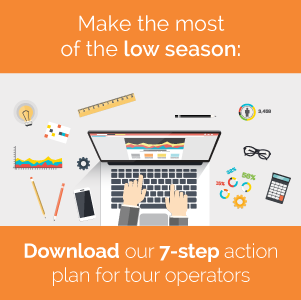
Inbound tourism is a thriving industry. According to estimates by Tourism Australia, it’s an opportunity worth $26 billion – even though it only makes up 25% of the total local tourism market.
International tourists spend more money on their trips than their domestic counterparts, and a good chunk of their disposable income should rightly go to local tour and attraction providers. Yet, marketing a tour or activity product in an international market is no easy task and requires some strategic planning in order to be successful.
Here are six vital questions you need to ask yourself before targeting inbound travellers.
Is your tour or attraction established enough?
Marketing to inbound tourists is a long term game. It requires clear goals, dedication, resources and patience. If your tour or attraction business is still looking to establish itself in the domestic market, you’re unlikely to be able to commit the focus or manpower that internation tourism plans require.
However, that doesn’t mean you should completely park your plans for later. It’s the perfect time to forge partnerships with Regional Tourism Organisations (RTOs) and State Tourism Organisations (STOs) who cannot only give you strategic advice in the early days, but also support your marketing efforts with domestic and international travellers.
If your business is already well-established, you should commit at least 8 hours per week to put your plan into action. Setting a regular appointment in your diary will ensure steady progress.
Do you understand your inbound target market?
When you’re looking to attract inbound travellers you should start with one well-defined geographic audience and understand their needs and wants thoroughly. Determining your ideal target market requires a lot more thinking than simply finding out what the biggest growth market for inbound travel is. Just because Australia is welcoming more and more Chinese tourists every year, it doesn’t mean that they are likely to stay in your region or have a natural interest in your high-adrenaline jet boat tours.
Defining your ideal inbound target audience should start with what you’re offering as a business. If you’re providing exclusive tours in remote areas of the country you will want to attract a different age group and nationality than a city bungee jumping company. For instance, the latter might appeal more to the European backpacker than the middle class couple from India.
A good starting point is to find out which nationalities you most frequently attract organically without marketing specifically to them. This could be a low hanging fruit on your path to inbound tourism success. Visit Tourism Australia’s Corporate site to view their Market Profiles. This is where you can find market profiles on each major inbound market for Australia and gain more insight on whether your product is suitable for your chosen market.
Can you support the higher marketing costs to compete in a global market?
While inbound tourism can be a very lucrative business, it also requires you to invest much more significantly in marketing your tour or attraction. You’re no longer just competing with your domestic colleagues, but also with a vast number of other attractive destinations around the globe.
The higher level of competition means that you need to spend more on your marketing efforts to achieve the required visibility. RTOs and STO have to play a big part here to ensure that your region is seen as an attractive destination for international travellers.
the required visibility. RTOs and STO have to play a big part here to ensure that your region is seen as an attractive destination for international travellers.
Do you sell through the right distribution channels?
Distribution channels, such as inbound tour operators, are a vital means to get your tour or attraction product in front of the right audience. Depending on your geographic target market, the available distribution channels can range from very simple to vastly confusing. That’s why it’s important that you develop a good understanding of the distribution channels that will be most important to your inbound audience so you can build relationships and sell through them once your product is ready.
At this point you may also want to review whether your booking system integrates seamlessly with foreign distribution channels. It will make your launch into the inbound market a much smoother ride.
Do you have inbound-ready rates?
To launch into a new international market you will need to understand how to work with trade and distribution who are active in your chosen markets. Most Inbound Tour Operators (ITOs), for example, ask for a minimum of 25% nett rates (that is, 25% off your retail rate) and others insist on up to 30%. Don’t let these amounts scare you.
If you have built these discounts into your pricing structure then your profit margins will be protected and the cost of these sales (the 25% or 30%) will allow you to work profitably with the right distribution or trade partners. Don’t forget that working with distributors means your product has ready-made reach into your chosen market. The distributors can offer you the opportunity to participate in relevant campaigns, and often they have sale reps on the ground.
Are you and your staff able to overcome potential language barriers and cultural differences?
While it may seem obvious that inbound travellers have different travel expectations depending on their cultural background and their language capabilities, it’s often an aspect that is forgotten about until you run into major problems. For example, if the majority of your customers are Chinese tourists and only speak little English, how are you going to communicate with them?
Thinking and planning for this early on in your inbound travel expansion plans will avoid customer and staff frustration, and set you up for long term inbound tourism success.
Are you looking for more tips to help your tour, activities or attraction business thrive? Download our 7-step action plan to learn how you can use the low season to your advantage.
Booking Boss is an online booking system for tour operators and attraction providers. Trusted by many in the tourism industry, Booking Boss is about getting you out of the spreadsheets and into the sun. We provide free education resources for operators like you, to make your business the best it can possibly be.








Comments